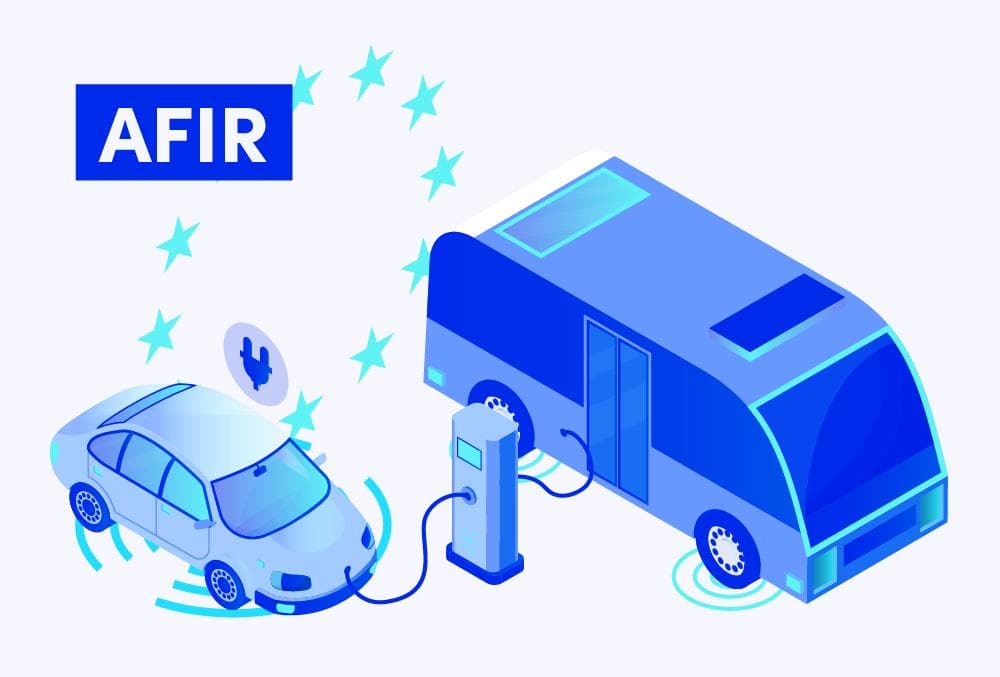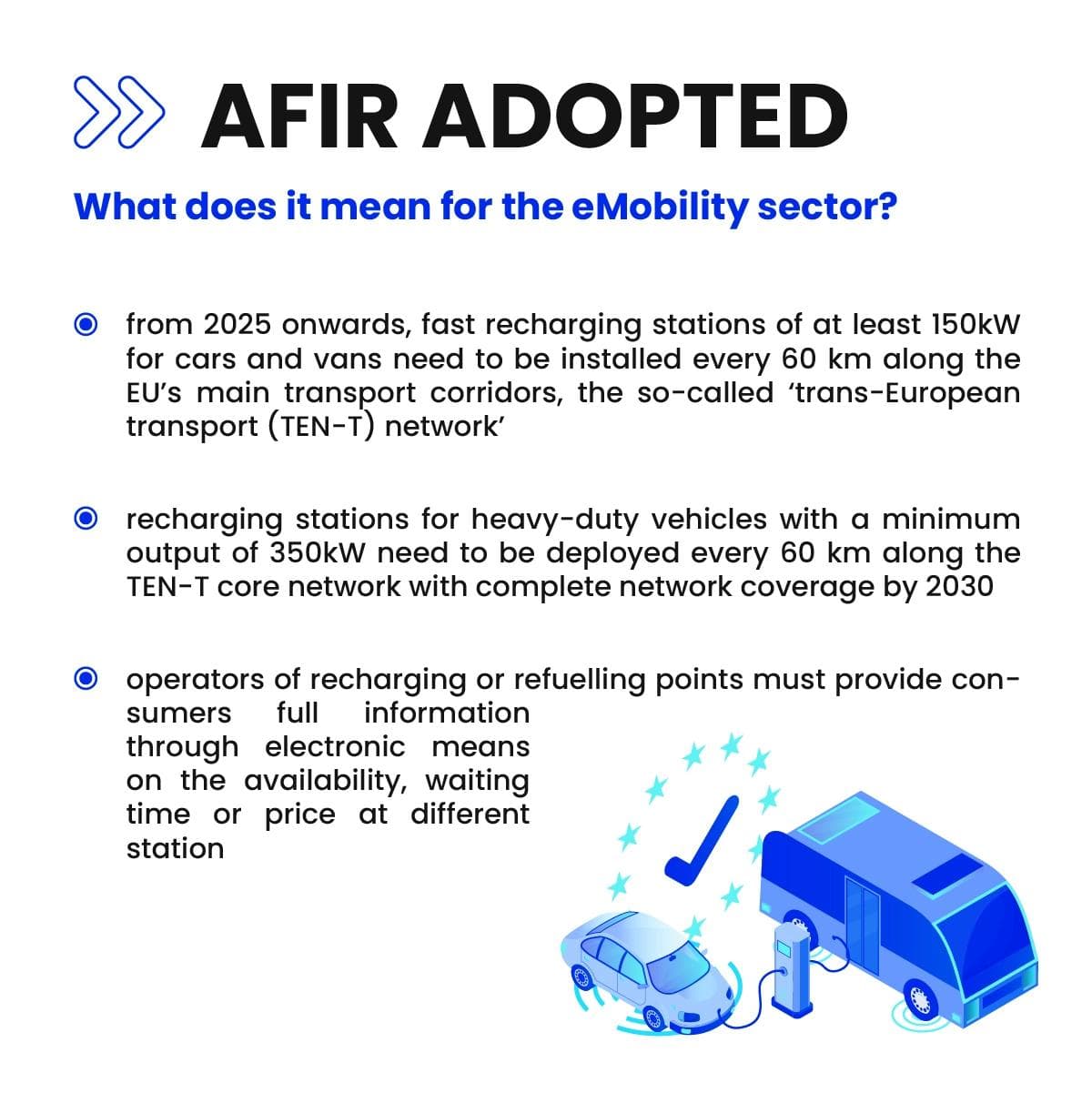The EU’s green transition is no longer just a buzzword, it’s a full-throttle movement. Among the most transformative regulations driving this shift is the Alternative Fuels Infrastructure Regulation (AFIR). Introduced as part of the EU's Fit for 55 package, AFIR officially rolled out on April 13, 2024, setting binding infrastructure targets for the entire EU.
This isn’t just a policy update. AFIR fundamentally redefines the mobility sector, affecting everyone from transport ministries and city planners to Charge Point Operators (CPOs) and clean-tech startups.
What is AFIR?
AFIR (Alternative Fuels Infrastructure Regulation) is a European Union regulation that sets binding requirements for the deployment, accessibility, and functionality of alternative fuel infrastructure, such as EV charging and hydrogen refuelling, across all EU member states.
AFIR (Regulation (EU) 2023/1804) replaces the former Directive 2014/94/EU, shifting from a directive, which allowed each country to interpret and implement the rules individually, to a regulation that is directly and uniformly applicable across all EU Member States. This change eliminates inconsistencies and ensures a more harmonized rollout of clean transport infrastructure throughout the continent.
AFIR’s core objectives:
- Deploy minimum recharging stations for electric vehicles and hydrogen refuelling stations along the TEN-T core and comprehensive networks.
- Standardize the user experience, including ad hoc payment options and clear, transparent pricing.
- Promote interoperability and real-time availability of data for all publicly accessible recharging stations.
- Ensure that all EV chargers are digitally connected and support smart charging capabilities.
Why AFIR matters
1. Driving environmental sustainability
By accelerating the adoption of alternative fuel, think electricity, hydrogen, and low-carbon fuels, AFIR is a cornerstone of the EU’s goal to hit climate neutrality by 2050.
2. Unlocking economic opportunity
From EV charger with payment terminal manufacturers to smart-grid integrators, AFIR is a growth engine. It fosters infrastructure investment, sparks innovation, and opens new doors across the entire mobility sector.
3. Making EV use seamless across borders
AFIR ensures a consistent user experience—wherever you go. Whether it’s enabling ad hoc payments, showing transparent pricing, or unifying access across networks, EV drivers will finally get the frictionless experience they’ve been waiting for.
What AFIR means for Charge Point Operators
If you’re a CPO, this one’s for you. AFIR sets out a clear rulebook to ensure that the growing network of EV infrastructure is not only widespread but usable.
Mandatory ad-hoc payment options
No more app-only or subscription-only access. CPOs must now offer accessible payment solutions:
- Chargers ≥50 kW must have a payment terminal accepting common debit and credit cards.
- Chargers <50 kW can use secure alternatives like QR code-based ad hoc payment systems.
Transparent pricing
All prices must be easy to spot and understand. That includes:
- Cost per kWh
- Session fees
- Idle time penalties
This info must be displayed on the charger screen or physically on the unit.
Digital connectivity and data sharing
Every public recharging station must be:
- Remotely manageable
- Integrated with real-time availability and price data
- Open for navigation apps and platform access
Ready for smart charging
All infrastructure must support smart charging and load balancing. That means CPOs need to think ahead; your grid-friendly tech needs to be ready for tomorrow’s demand today.
What does “Fair” look like under AFIR?
AFIR is more than infrastructure. It’s about equity, transparency, and practicality.
- Equal access: From cross-border drivers to weekend warriors, everyone gets the same experience, no matter their provider.
- Transparent cost structures: Hidden fees? Gone. App-only access? Not anymore. Ad hoc payments are now standard.
- Balanced deployment: While high-traffic corridors get heavy investment, AFIR also mandates coverage for lower-demand regions, creating a truly inclusive network.
The Bigger Picture Behind AFIR: Understanding Fit for 55
To really grasp what AFIR is about, it helps to see where it fits within the broader climate agenda. AFIR is part of a wider initiative known as Fit for 55, a comprehensive strategy designed to help the European Union reduce greenhouse gas emissions by at least 55% by 2030, compared to 1990 levels.
This package was developed with input from lawmakers and industry, aiming to align climate goals with economic competitiveness. It sets clear ground rules for businesses and policymakers across the continent, encouraging sustainable growth while positioning the EU as a global leader in climate action.
What’s Included in Fit for 55?
Fit for 55 includes a range of interconnected policies. Each one tackles a specific piece of the green transition puzzle:
- EU Emissions Trading System (ETS): ETS is a market-based mechanism that has helped cut emissions in power generation and heavy industry by over 40% since 2005. By putting a price on carbon, it incentivizes more efficient and cleaner operations.
- Carbon Border Adjustment Mechanism (CBAM): CBAM helps prevent companies from outsourcing emissions by imposing a carbon price on imported goods. It ensures that efforts within the EU are not undermined by high-emission imports and aligns with international trade rules.
- Member states’ emissions reduction targets: The Effort Sharing Regulation assigns annual emission limits to sectors not covered by ETS, such as buildings, road transport, and agriculture. This helps maintain accountability at the national level.
- Land Use, Land Use Change and Forestry (LULUCF): The EU targets at least 310 million tonnes of CO₂ equivalent in net removals by 2030 through better forest management and sustainable land use. Each Member State has a tailored contribution to reach this target.
- CO₂ emission standards for cars and vans: The proposal aims to cut vehicle emissions to zero by 2035. That means all new cars and vans sold in the EU will have to be fully electric or use other zero-emission technologies.
- Methane emissions in the energy sector: As part of the EU Methane Strategy and the Global Methane Pledge, this policy focuses on improving tracking and reducing methane emissions by 30%, a critical step in tackling short-term climate impacts.
- Greener fuels for shipping: The FuelEU Maritime initiative aims to reduce the greenhouse gas intensity of maritime fuels by up to 75% over the next 30 years. This effort seeks to move the shipping industry away from its reliance on fossil fuels.
- Alternative Fuels Infrastructure (AFIR): And finally, AFIR ties the entire transition to what’s happening on the ground. It ensures that the infrastructure for alternative fuel, such as electric and hydrogen charging stations, is in place across Europe to support cleaner transport.
AFIR timeline & milestones as of 2025
The clock is ticking, and for many, it already has.The Alternative Fuels Infrastructure Regulation (AFIR) is well underway. Here's what has already taken effect and what's still coming:
April 13, 2024: AFIR entered into force
All public EV charging points in the EU must support direct, digital payments with clear pricing - no subscriptions, no pre-registration.
Solidstudio's solution was built to meet these requirements from day one.
By end of 2025: Infrastructure density requirements (underway)
AFIR mandates a baseline of charging and refueling coverage across key EU transport corridors:
- EV charging: Public charging stations must be installed at least every 60 km along the TEN-T core network.
- Hydrogen refueling: Stations must be available in every urban node and every 200 km on the TEN-T core network.
National plans are being reviewed and enforced. Non-compliance risks fines and public funding restrictions.
By 2030: Full network integration
Several high-impact infrastructure goals remain on the horizon:
- Heavy-duty vehicle support: Comprehensive EV charging coverage across the TEN-T core and comprehensive networks for heavy-duty vehicles.
- Ports: Onshore power supply must be available for maritime TEN-T ports to reduce ship emissions while docked.
- Airports: AFIR requires clean energy systems to reduce emissions at the gate (e.g., ground power units, pre-conditioned air).
What this means for CPOs in 2025
- Payment compliance is no longer optional, it’s enforceable.
- Infrastructure goals are scaling rapidly and require flexible, future-proof payment systems.
- Catching up gets harder every quarter as pressure mounts from regulators, funding bodies, and competitive networks.
Don’t wait for 2030. Future-proof your payment and compliance systems today.
Ready to get AFIR-compliant? Let’s build smarter infrastructure together
AFIR sets a new baseline for EV infrastructure, and Solidstudio is here to help you rise above it.
Our digital direct payment solution is tailor-made for Charge Point Operators who need to comply with ad hoc payment requirements fast, without the licensing headaches. It’s a plug-and-play gateway that enables secure, on-the-spot payments via card or QR code - no app or registration needed.
But this isn’t just a compliance patch.
- Use it as a standalone feature to meet AFIR payment obligations instantly
- Integrate it into your broader CPO or EMSP platform through open APIs or OCPI
- Customize it with value-added features like promotional coupons, multilingual receipts, or flexible pricing
Whether you're migrating a legacy system or planning your next deployment, our solution gives you a fast, reliable way to stay compliant, enhance driver experience, and scale confidently.
Want to see it in action? Let’s talk and make your infrastructure truly AFIR-ready.


